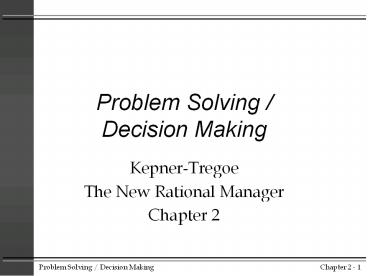Problem Solving Decision Making - PowerPoint PPT Presentation
1 / 21
Title:
Problem Solving Decision Making
Description:
... the skills need to solve the problem. they experience success in using those skills ... We've all experienced the 'solved' problem that isn't really solved. ... – PowerPoint PPT presentation
Number of Views:8590
Avg rating:3.0/5.0
Title: Problem Solving Decision Making
1
Problem Solving /Decision Making
- Kepner-Tregoe
- The New Rational Manager
- Chapter 2
2
Chapter 2 Contents
- Conditions Skills of Problem Solving
- Structure of a Problem
- The Process of Problem Analysis (PA)
3
People and Problems
- People like to solve problems and will seek them
out if four conditions are met - they posses the skills need to solve the problem
- they experience success in using those skills
- they are rewarded for being successful
- they do not fear failure
4
Problem Analysis
- Problem Analysis (PA) provides the skills needed
to explain any situation in which an expected
level of performance is not being achieved and in
which the cause of the unacceptable performance
is unknown.
5
PA Continued
- We are concerned with the way in which
information is used to approach deviation in
performance. - Decision making based on FACTS and DATA!
6
Problems Not Solved
- Weve all experienced the solved problem that
isnt really solved. - Problem solving by extrapolation
- need solution quick - no time
- rely on memories
- past similar problems
- past successes
7
K-Ts View of Problem Solving vs Decision Making
- A decision requires answers to questions of the
form - How?
- Which?
- A problem always requires an answer to the
question - Why?
8
The Two Forms of Problems
- Performance once met the SHOULD and no longer
does. - See Figure 1 (W p 25, B p 37)
- ACTUAL performance has always been below SHOULD.
- See Figure 2 (W p 25, B p 37)
9
Techniques of PA
- State the Problem
- Specify the Problem
- Develop Possible Causes
- Test Possible Causes
- Determine the Most Probable Cause
- Verify Assumptions, Observe, Experiment, or Try a
Fix and Monitor
10
Case History
- Review the Leaking Soybean Oil Filter case
- It is used extensively throughout the remainder
of the chapter - Also review the PA_Worksheet template
11
Problem Statement
- Name the Problem
- Be precise
- Is the deviation from SHOULD clear
- Is the cause unknown
- Case
- Number One Filter Leaking Oil
- An important paragraph (W p 29, not in B but I
will provide)
12
Specify the Problem
- Describe the problem in detail using four
dimensions - What - identify the deviation we are trying to
explain - Where - location of the deviation
- When - timing of the deviation
- Extent - magnitude of the deviation
- See Fig 3, (W p 30, B p 41-42) - IS col.
13
IS and IS NOT
- Any problem can be described by answering the IS
specifying questions - question wording may need to be modified to suit
especially for a human performance problem - establish problem detection facts data
- Next we need a basis of comparison
- What COULD BE but IS NOT
14
IS NOT
- Nothing is more conducive to sound analysis than
some relevant basis of comparison - Search in all four dimensions looking for Closest
Logical Comparison - This narrows the scope of the search for cause
isolates distinguishing features - Fig 4, (W p 33, B p 44-45) - IS NOT col.
15
Develop Possible Causes
- We will use Distinctions and Changes to lead us
to Possible Causes. - As we proceed, remember
- knowledge and experience are key
- brainstorm - dont close too quickly
- cast a large net
16
Distinctions
- Ask what is distinctive about (the IS data) when
compared with (the IS NOT data)? - for all specifying questions in all dimensions.
- See Figure 5, (W p 36-37, B p 48-49)
17
Changes
- We now search for the of change between
acceptable and unacceptable performance (remember
Figure 1) - What changed in, on, around, or about each
Distinction? - See Figure 6, (W p 39, B p 51) - Distinction
column
18
Possible Causes
- If all relevant information about a problem has
been obtained, the explanation of cause will
emerge - Ask how could this distinction (or this change)
have produced the deviation described in the
problem statement. - See Possible Causes on pages (W p 40- 41, B p
52-53)
19
Test Possible Causes
- Test Possible Causes
- Does it explain the WHAT, WHERE, WHEN, and
EXTENT? - Does it require no (or minimal) additional
assumptions to make it work? - Are necessary assumptions reasonable?
- Identify the most likely possible cause.
20
Confirm Cause
- Confirmation seeks to verify the cause and effect
relationship - additional information
- additional actions
- Observe
- Experiment
- Fix and Monitor
21
Most Common Causes of Failure
- Using inaccurate or vague information
- Insufficiently identification of key distinctions
and changes - Allowing assumptions to distort judgement
- PA is a process, not a Panacea
- review concluding comments (W p 46 - 47, B p 54 -
55)

